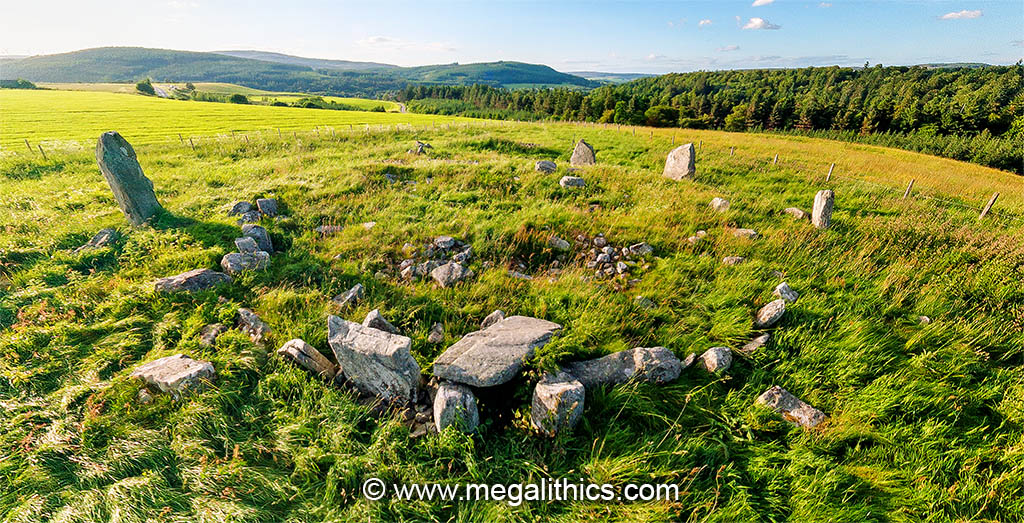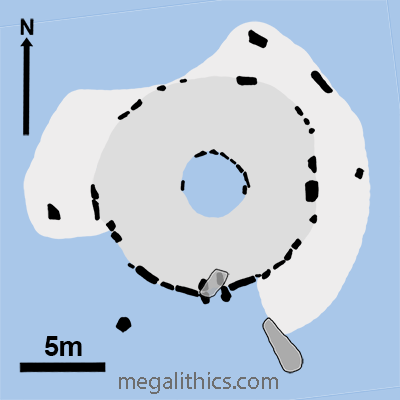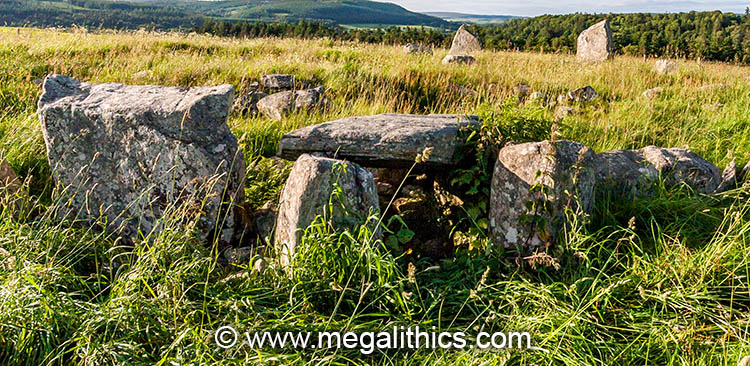 |
| NJ 17657 35856 (GPS 52min) Centre | Diameter - 13m Outer kerb (meas.), 21.7m Stone Circle (Est.) |
| Visited June 2010 | Alt.197m OD (GPS) |
 |
Lagmore West ( BAN 1 ), also known as Upper Lagmore, is a Clava Passage Grave in a fairly ruinous state of preservation. The cairn is situated about 12km SW of Clarlestown of Aberlour and 750m SSW of Ballindalloch Castle on a hillside overlooking the confluence of the rivers Avon and Spey. The setting is quite dramatic with panoramic views and is inter-visible with the monument at Lagmore East to the ENE.

PUBLISHED ACCOUNTS
For such an obvious cairn with multiple large surviving circle stones, there is very little mention of Lagmore in the early literature.
The inimitable Fred Coles visited both of the
Lagmore monuments , and in 1907 published
(1)
an excellent plan of the cairn and several very accurate
illustrations (see Antiquarian Images section). He commented on the confusing
nature of the site and its apparent complexity " it may be safely asserted that,
of all the many half-ruined, half-excavated Stone Circles measured during the
course of the present surveys, this one at Lagmore is the most complicated, and
possessed probably also the most interesting and specialised " overground
phenomena "—all left now in a condition of almost inextricable confusion." Fred
incorrectly planned three rings of kerb stones and also misinterpreted the
lintelled passage entrance remains as a cist.
Henshall describes Lagmore in detail in her opus
(2)
and her later expansion work
(3)
providing a detailed plan diagram. She also mentioned about the confused nature
of the site that was reported by Coles, "stones have been dumped on and around
the cairn, and large stones which presumably derive from the structure lie about
the site: together they inhibit and confuse interpretation fo the remains".
Burl (4) makes only very brief mentions of Lagmore, but does include it as an entry in his gazetteer.
Bradley (5) mentions Lagmore several times in "The Good Stones", but the work is mainly focused on the Balnuaran cemetery. Lagmore is mainly mentioned with respect to landscape distribution and placement, and especially, monument intervisibilty.
We could find no reference of any excavations at the site in any of the above works, and presume it is still unexcavated.
THE CAIRN
Lagmore West is situated high on the side of a valley, but on level ground, it is much robbed and ruined, but all of the characteristic components of a Clava Passage Grave are evident.
The outer ring of kerb stones has gaps, but is visible around the whole circle, its diameter seems to have been around 13m. The outer kerbs were surrounded, and presumably supported, by banking which extended out about 3m, just passing the monoliths of the stone circle. The banking has been robbed away to the NW and SW but still survives to some extent, around the rest of the cairn circumference. The surviving banking is up to 0.5m high and hides much of the height of some surviving kerbs, because of this it was hard for us to get any idea of possible size/height gradation in the kerbs, which is a common feature of Clava monuments.

There is an almost continuous run of outer kerb stones on the southern side and the passage entrance is located here, nearly at true south. The entrance is flanked by two very large, but mismatched, kerbs, indeed the western stone is probably the largest in the outer ring,1.22m tall and 1.45m wide, the eastern stone is much wider, but less than half as tall. Between the two kerbs are two passage stones, set radially to the cairn, they project out past the circumference of the outer kerb ring, if the roofing projected out as far, then they would have formed a small "porch" area. Behind these are another two passage wall stones and all four are covered by a large lintel slab which is presently displaced so that it rests on only three of the passage stones. Fred Coles erroneously thought that this structure was a disturbed cist, which is understandable as no other trace of the passage structure is visible.
The four passage stones seem undisturbed and unless the passage had a strong curvature to the east, must have entered the central chamber on its west side. Seven contiguous stones of the central chamber walling survive in the north to east quadrant, and one other walling stone is visible to the west. These stones give an original diameter of around 3.6m for the central chamber at ground level, nothing of the structure survives above this. We did find a pit in the cairn interior that revealed a large flat stone resting on others beneath, "roofing" a hollow space. This was roughly aligned with the existing passage stones, but as their is no record of any surviving passage elements beyond the entrance area, we suppose this feature is a result of debris stacking.
The cairn was surrounded by a free standing stone circle of which only five stones survive in situ. There is an arc of three ?sequential stones in the north to east quadrant, their heights are 1.7m, 1.8m and 1.35m respectively. If these stones are truly sequential, and there are no missing stones in this arc, then the stone spacing of the circle was very irregular. There is a large stone standing at the west, and is the tallest survivor at 2.4m, the stump of the fifth stone is at the SW, less than half a metre tall. A large stone lies fallen at the SSE, it is 3.5m long and 1.2m wide, it appears to lie where it fell outwards. All of the surviving stones have damaged tops, probably due to weathering, and they all seem to have relatively flat inner and outer faces. It is tempting to think that they originally had the classic "playing card" shape seen in the circles at better preserved Clava monuments.
The remains of the monument at Lagmore East (also called Lagmore Lower) are visible from the cairn to the ENE, about 300m away and 35m lower in height. There are three stones still standing and two fallen around the remains of a low cairn, there is not enough remaining evidence to conclusively identify this as a Clava monument, but given the close proximity to Lagmore West, we think this is highly likely. From Lagmore East, the circle stones at Lagmore West are silhouetted dramatically on the skyline.
1.
Coles, F.,
Proceedings of the Society of Antiquaries of
Scotland, 41, p.141-9,1907.
2.
Henshall, A. S.,
The Chambered Cairns of Scotland,
p.389-90, Edinburgh University Press, 1963,
Edinburgh.
3.
Henshall, A. S. and Ritchie J. N. G., The Chambered
Cairns of the Central Highlands, p.236-7,
Edinburgh University Press, 2001, Edinburgh.
4.
Burl A.
The Stone Circles of Britain, Ireland and Brittany,
p.170, 177, 355, Yale University Press, 1976,
London.
5.
Bradley, R., "The Good Stones, A New Investigation of the
Clava Cairns", Society of Antiquaries of Scotland
Monograph Series Number 17, p. 24, 178, 180, 182, Edinburgh 2000.